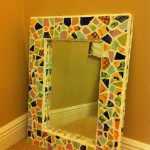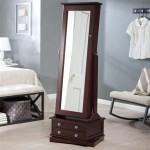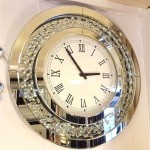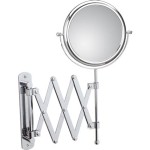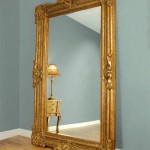Mirrors for Small Spaces
Mirrors offer a versatile design element with the power to transform small spaces. Their reflective properties can create the illusion of depth and spaciousness, enhancing both the aesthetic appeal and functionality of compact rooms. Understanding how to strategically employ mirrors can significantly impact the perception of size and light within a confined area.
One of the most effective ways to utilize mirrors in small spaces is to place them opposite windows. This placement allows the mirror to reflect natural light deeper into the room, brightening the space and creating a sense of airiness. The reflection of the outdoor view also adds a dimension of depth, visually extending the room beyond its physical boundaries.
Large mirrors can have a dramatic impact on the perceived size of a room. A strategically placed oversized mirror on a wall can visually double the space, making it feel significantly larger. Leaning a large mirror against a wall offers a more casual approach while still providing the illusion of expanded space. This technique is particularly effective in narrow hallways or small bedrooms.
In addition to size and placement, the shape and style of a mirror can contribute to its effectiveness in a small space. Round or oval mirrors can soften the lines of a room and create a sense of flow. These shapes are particularly well-suited for bathrooms or hallways. Rectangular or square mirrors, on the other hand, can add a touch of modern elegance and work well in living rooms or dining areas.
Mirrored furniture offers a subtle way to incorporate reflective surfaces into a small space. Mirrored nightstands, console tables, or wardrobe doors can add a touch of glamour while simultaneously enhancing the feeling of spaciousness. The reflective surfaces of these pieces bounce light around the room, creating a brighter and more open atmosphere.
Creating a gallery wall of smaller mirrors can be a stylish and effective way to add visual interest and expand the perceived space. Arranging mirrors of different shapes and sizes creates a focal point while simultaneously reflecting light and creating a sense of depth. This technique works particularly well in hallways or dining areas.
The frame of a mirror can also play a significant role in its overall impact. Thin or minimalist frames tend to blend seamlessly into the background, maximizing the reflective surface and emphasizing the illusion of space. Ornate or bolder frames, however, can add a decorative element and serve as a focal point in the room. The choice of frame depends on the overall style and aesthetic of the space.
When using mirrors in small spaces, it's important to consider what the mirror is reflecting. Avoid placing mirrors opposite cluttered areas or unattractive features, as this will only amplify the visual clutter. Instead, focus on reflecting light sources, appealing artwork, or open spaces to maximize the positive impact of the mirror.
Incorporating mirrored tiles into a backsplash or accent wall can add a unique and stylish touch while expanding the perceived space. The reflective surfaces of the tiles create a sense of depth and bounce light around the room, making it feel brighter and more open. This technique is particularly effective in kitchens and bathrooms.
Using mirrors strategically in small spaces requires careful consideration of size, placement, shape, and style. By understanding the reflective properties of mirrors and how they interact with light and space, one can effectively utilize these versatile design elements to create the illusion of a larger, brighter, and more inviting environment.
Consider the specific needs and limitations of the space when selecting a mirror. For example, a full-length mirror is essential for a small bedroom, while a smaller decorative mirror might be more appropriate for a powder room. The placement of the mirror should also be carefully considered to maximize its impact on the overall perception of the space.
Experimenting with different types of mirrors and placements can help determine the most effective strategy for a particular space. Trying out different sizes, shapes, and styles can lead to unexpected and visually appealing results. The key is to use mirrors thoughtfully and strategically to enhance the functionality and aesthetic appeal of the small space.
The use of mirrors in interior design offers a cost-effective and versatile solution for maximizing space and light in compact living areas. By understanding the principles of reflection and strategically incorporating mirrors into the design scheme, one can transform a small space into a functional and aesthetically pleasing environment.
Utilizing mirrors effectively can create a significant difference in how a small space is perceived. Through careful planning and thoughtful placement, mirrors can be used to create an illusion of spaciousness and light, making a small room feel more open and inviting. This makes mirrors a valuable tool in any small space design project.

Best Mirrors To Make Small Bedrooms Bathrooms Look Big
:strip_icc()/cdn.cliqueinc.com__cache__posts__233334__for-real-this-is-how-to-make-a-small-room-look-bigger-2372573.700x0c-8bf6e438f8ac4036b690d3b59044e997.jpg?strip=all)
8 Gorgeous Small Space Ideas

11 Ways To Use Mirrors Make Your Space Look Bigger

Mirrors In Small Spaces Tips To Using

Before After Enhancing Small Indoor Outdoor Spaces With Mirrors The Tiny C Cottage
:strip_icc()/cdn.cliqueinc.com__cache__posts__199530__this-one-trick-will-make-every-small-room-seem-larger-1858901-1470327592.700x0c-8f0f2207baae4068be054d7c9419e84d.jpg?strip=all)
8 Gorgeous Small Space Ideas

17 Tips Tricks For Small Space Living

Decoración De Unas Espejos Pared Decoracion Interiores

The Best Glass Decor For Small Space Solutions Homemydesign

10 Tips For Using Mirrors As Decor


